July 5, 2022 | Toronto Star
June 28, 2023 | Newstalk 1010

The Department congratulates our faculty members for their promotions effective June 30, 2023:
- Mason Ghafghazi is promoted from assistant professor to associate professor
- Daniel Posen is promoted from assistant professor to associate professor.
Dean Chris Yip announces Prof. Marianne Hatzopoulou (CivE PhD 0T8) as new CivMin Chair
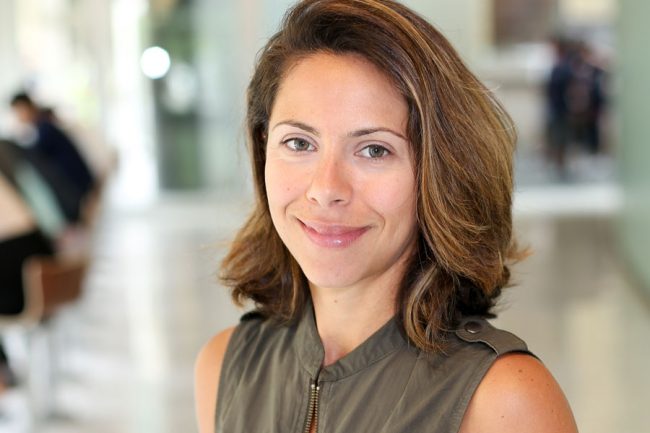
To: Members of the Faculty of Applied Science and Engineering
From: Christopher Yip, Dean
Date: June 28, 2023
Re: Appointment of Chair, Civil and Mineral Engineering
I am pleased to announce the appointment of Professor Marianne Hatzopoulou (CivE PhD 0T8) as Chair of the Department of Civil & Mineral Engineering (CivMin) for a five-year term beginning on July 1, 2023, and ending June 30, 2028.
Professor Hatzopoulou joined CivMin in 2015 as an Associate Professor and was promoted to full Professor in 2020. In 2021, she was on a team which received the NSERC Brockhouse Canada Prize for Interdisciplinary Research in Science and Engineering, and in 2022 as an alumna (CivE PhD 0T8), she received the U of T Engineering Alumni Network 2T5 Mid-Career Achievement Award. Marianne is a Tier 1 Canada Research Chair in Transport Decarbonization and Air Quality, and has authored more than 150 refereed journal papers in the area of transportation, air quality and greenhouse gas emissions. She is also an associate editor of the journal Transportation Research Part D: Transport and the Environment.
Please join me in congratulating Marianne on her appointment and wishing her a rewarding journey for her term.
I extend my deep appreciation to the following members of the Advisory Committee in this search for their time and thoughtful input:
Kelly Lyons, Professor and Acting Vice Dean Research and Program Innovation, SGS
Khandker Nurul Habib, Professor, Civil & Mineral Engineering
Robert Andrews, Professor, Civil & Mineral Engineering
John Harrison, Professor, Civil & Mineral Engineering
Kamran Esmaeili, Associate Professor, Civil & Mineral Engineering
Susan Andrews, Professor, Civil & Mineral Engineering
Daniel Posen, Assistant Professor, Civil & Mineral Engineering
Ramin Farnood, Professor and Chair, Chemical Engineering & Applied Chemistry
Sean Thomas, Professor and Associate Dean Research, John H. Daniels Faculty of Architecture, Landscape and Design
Aly Abdelaziz, Graduate Student, Civil & Mineral Engineering
Alec Gilvesy, Undergraduate Student, Civil & Mineral Engineering
Michelle Deeton, Director Finance & Administration, Civil & Mineral Engineering
I also would like to take this opportunity to extend gratitude on behalf of the Faculty to Professor Brent Sleep, who served as the Chair of CivMin since July 1, 2013. Under Brent’s leadership, the department’s name changed to reflect the synergies between civil and mineral engineering education and research, graduate enrolment and research funding increased, unique partnerships flourished and several ambitious infrastructure projects were completed. Notably, during Brent’s second term as Chair, the site of U of T’s Camp at Gull Lake was renovated extensively, building on a legacy that is more than 100 years old. The impact of Brent’s leadership will be felt by the entire U of T Engineering community for years to come.
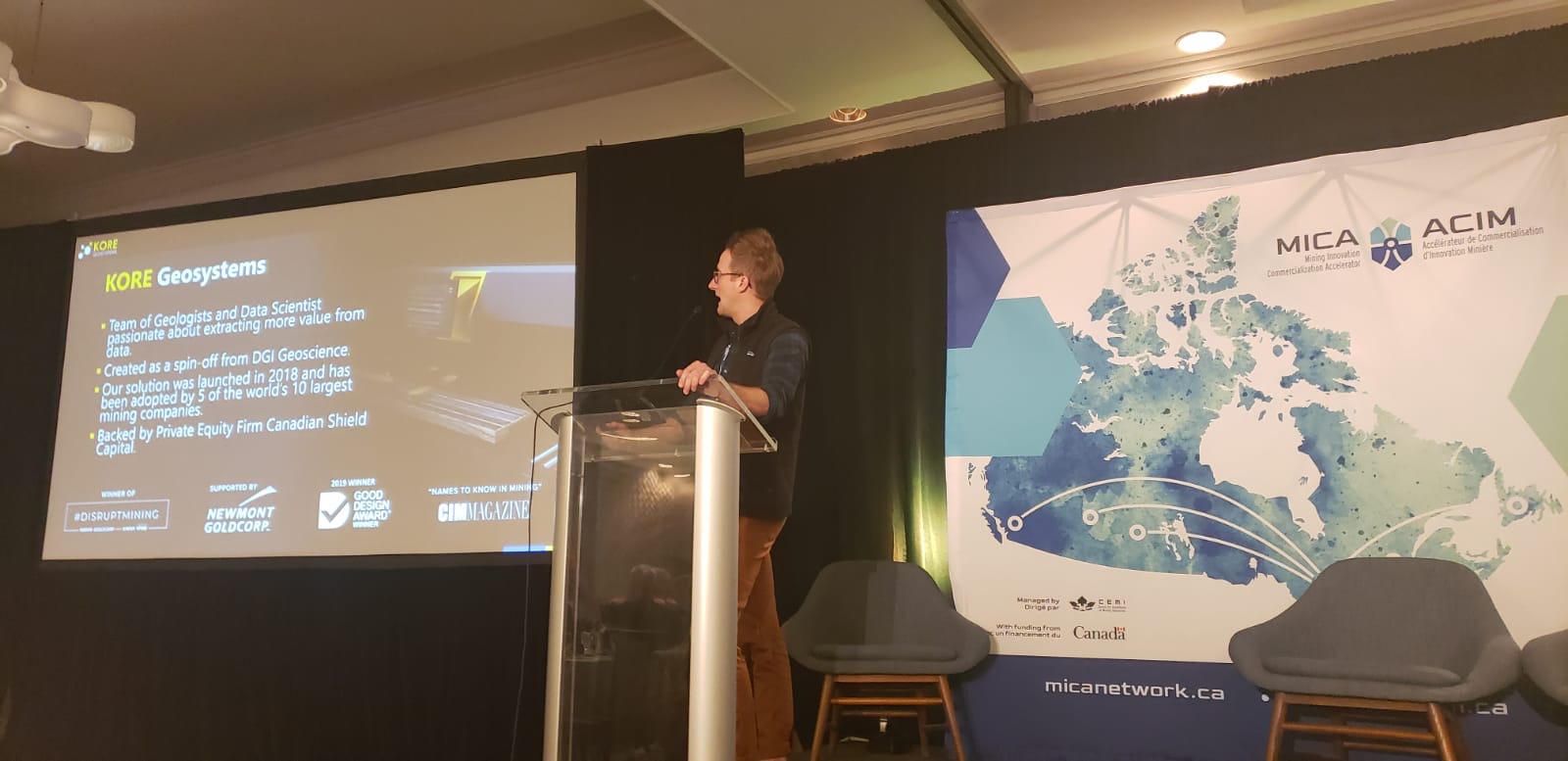
KORE Geosystems, one of whose founders is a CivMin professor and alumnus, has received federal funding of $1 million towards an innovative process in the mining sector. The proposed innovation involves artificial intelligence (AI) automation in the evaluation of examining and logging core samples from exploration operations, solving one of the largest bottlenecks in the industry.
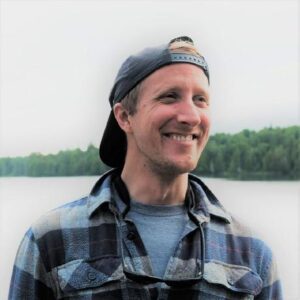
At the recent Mining Innovation Commercialization Accelerator (MICA) Network conference, held in Toronto on Thursday, June 22, Professor Sebastian Goodfellow (MIE MASc 1T0, CivE PhD 1T5) presented for KORE. His proposal, titled “AI For Everyone: Accelerating core logging using a novel geologist-in-the-loop AI platform” requested $1 million towards the total project cost of $8 million. In all, the federal government presented 24 proposals with more than $15 million in funding, out of the more than 80 submissions.
Mining companies spend an exorbitant amount of money drilling, then cataloguing the details of the core samples. Some mine sites, known to drill 250,000 metres of samples each year, can spend hundreds of dollars per metre. “Drill core is an essential data source that informs critical processes throughout the mining lifecycle,” says Goodfellow. “A major industry challenge is that logging teams cannot accommodate the pace of drilling, resulting in massive backlogs representing unrealized investments and delayed decision-making.”
With this announcement positioning the funding as placing the environment and Canada in more competitive positioning, the release claims, “The Government of Canada is investing in innovative mining solutions that will better equip Canada’s mining sector to become a major industrial player in the new green economy.”
As nations look towards embracing a green economy, including the reduction of carbon emissions, large amounts of minerals such as graphite, copper, lithium and nickel will be needed to power the green and digital economy at home and around the world. The result is the need to drive and embrace efficiencies in the mining sector, both in labour, energy expenditure, timeliness and beyond.
Up for overcoming hurdles with this unique AI solution, Goodfellow explains, “It is challenging to grow logging teams because geologists are in short supply for reasons related to the great resignation, work-life balance, and an aging workforce.”
“If the team can scale, the increase in the team’s size results in a significant drop in consistency. The pace and consistency of logging represent one of the largest bottlenecks in the mining lifecycle. Our solution aims to improve productivity, eliminate backlogs, improve the consistency of logs, and enable remote work.”
Using an AI process to automate the examination, measuring and evaluation of specimens can easily replace the mundane, manual and traditional methods. First, a consistent method of imaging the samples in a tray is accomplished via standardized lighting and angle. Then the AI can scan the images and place holders to mark measurements on a screen – each catalog can be manually adjusted by an operator later if desired. All of the digitized images are accessible for reference and can be viewed remotely at any time.
Goodfellow notes the entire process is dependent upon human expertise, “Our AI models are built using a geologist-in-the-loop continuous learning approach, which allows the model to achieve greater accuracy in a drastically reduced amount of time by allowing the model to choose the data from which it learns. By incorporating geologists into the model training loop, the model is guided and corrected throughout its “life” building trust and drastically improving the scalability and impact of this technology. “
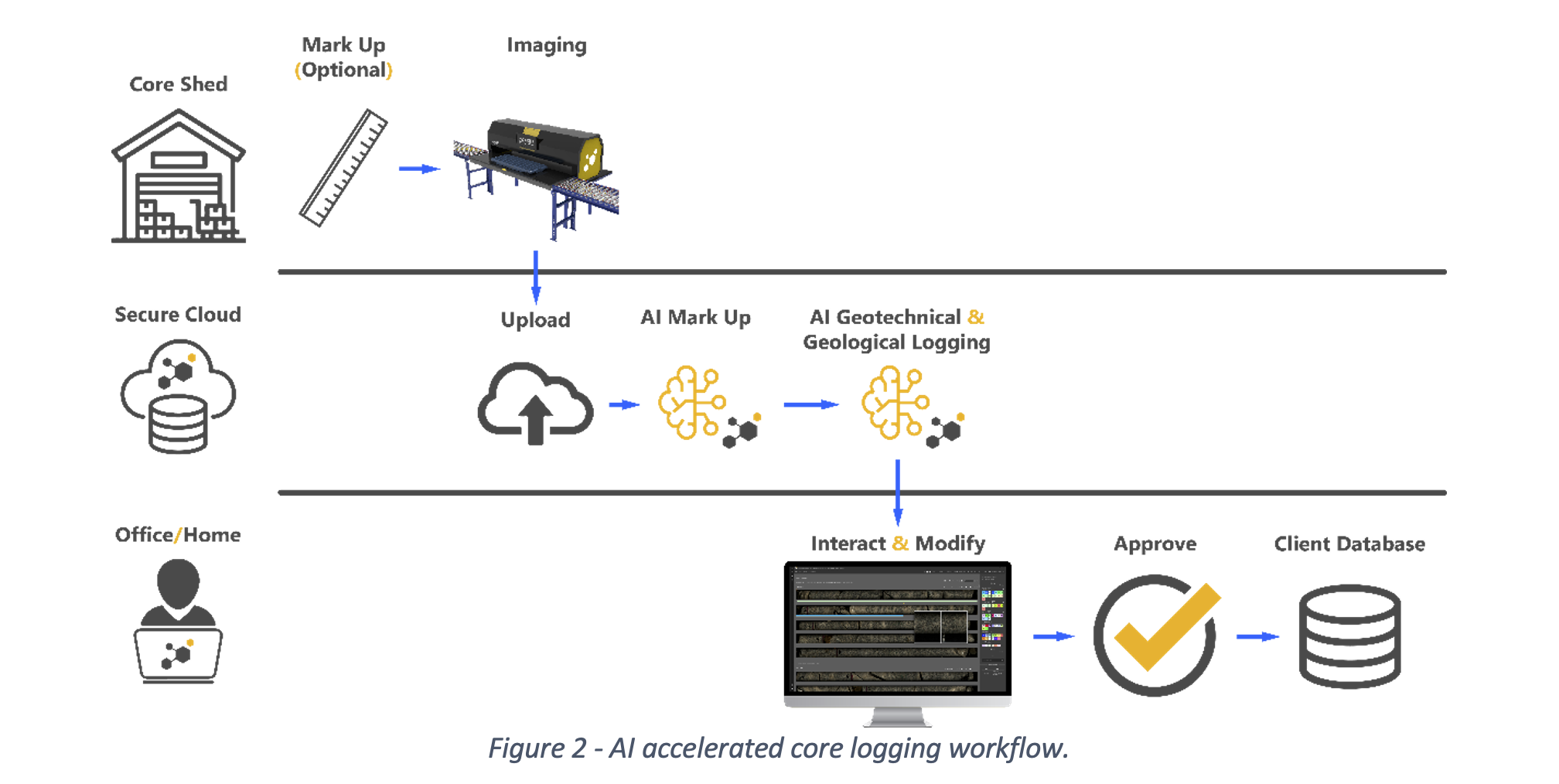
MICA’s call for proposals invited applicants to submit projects to position Canada as a global leader in mining innovation by accelerating the commercialization of made-in-Canada groundbreaking technologies.
Applications came from across Canada with projects spanning the four technical themes of MICA:
- Increase mine production capacity, at a lower cost.
- Reduce mining energy consumption and greenhouse gas emission
- Implement smart, autonomous mining systems.
- Reduce environmental risk and long-term liabilities.
According to a release by the federal government, MICA’s funding will allow the recipients to create new tools which will reduce carbon emissions, expand the use of autonomous driving for underground mining, and result in overall efficiencies enabling our domestic industry to become safer for personnel and the environment.
By Phill Snel
Professor Sebastian Goodfellow was recently featured in a U of T Magazine article, Tremors of the heart, about a collaborative project with clinicians using AI to detect heart rhythm abnormalities at Toronto’s Hospital for Sick Children (SickKids).
CivMin’s Professor Brent Sleep completes his role as two-term Chair
Professor Brent Sleep completes his role as Chair of the Department of Civil & Mineral Engineering (CivMin) as of June 30, 2023. We take a look back at the milestones and fond memories of his past 10 years at the helm, from 2013 to 2023.
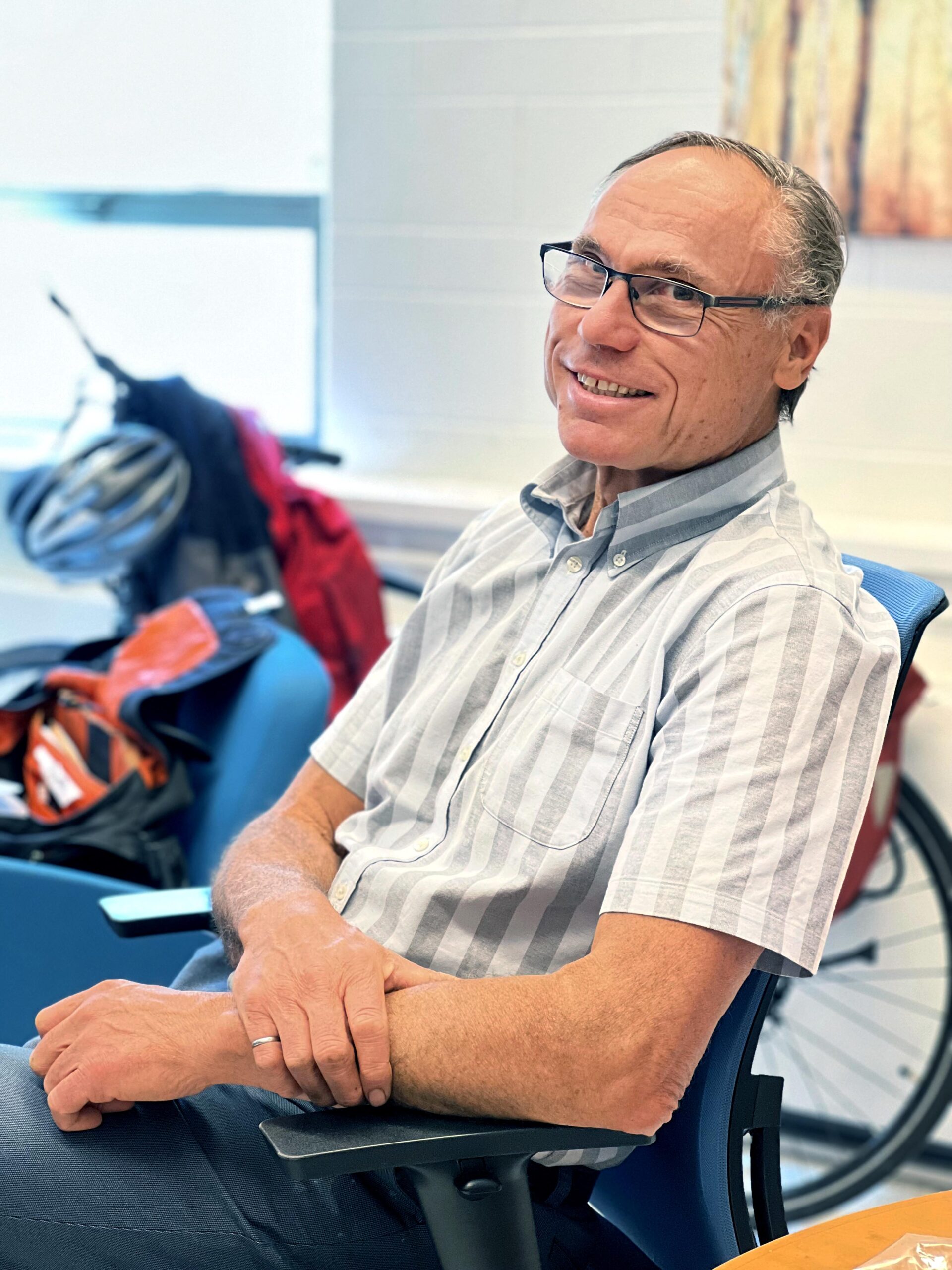
A familiar sight on St. George Street, along the U of T campus, many weekday mornings is a cyclist making a usual commute. This commuter, often sporting a red jacket, is headed for a corner office in the Galbraith Building, home to Engineering’s main entrance and CivMin’s leadership offices, specifically Office of the Chair.
Prof. Brent Sleep became Chair July 1, 2013 after first serving as associate chair, research from 2008-2012 and as acting director of the Lassonde Institute of Mining in 2012-2013. He joined us initially as an assistant professor in 1990, was promoted to associate professor in 1995 and to full professor in 2000.
Under his leadership, the Department changed its name from what had long been the Department of Civil Engineering (CivE), to the Department of Civil & Mineral Engineering in 2018 to better reflect the interdisciplinary aspects of the combined teaching and research fields, recognizing the breadth of experience of its faculty members and its strategic vision.
“We also rewrote the Constitution to make the Civil and Mineral programs more parallel to each other,” reflects Sleep on the deeper aspects of the name change. “We changed the structure so Mineral would have an associate chair and the Mineral Program would have equal representation on the various committees, particularly the undergraduate studies committee.”
“I’ve been able to hire so many new faculty. With 17 new professors over the past 10 years, 15 so far and two to be announced, it’s meant a great many interviews, meetings and letters. It’s been absolutely fantastic to bring in so many faces to CivMin,” he says with a familiar grin. In fact, seven of the last 15 new faculty members have been women, representing a rapid change for the Department.
Don’t forget to enjoy your time.
“Time management,” shares Sleep when asked about passing along advice to a new leader. “It’s really a full-time job, but you also want to keep your research program going and have time for your graduate students. But, also, don’t forget to enjoy your time too.
In reminiscing about the many socializing and networking events while the Chair, he says, “There’s a lot of great people, events and experiences. I’ll miss the opportunities to meet with a great many of our alumni, Industry Advisory Board and more – although I still hope to keep up connections through future department networking and social events”
You realize just how important the staff in the Department are in running it so well.
He’s quick to credit those who quietly keep the daily hum of the department going, “One of the things you realize is just how important the staff in the Department are in running it so well. All the directors, like Michelle, Nelly, Mel, and everybody else who’s in the Student Services team, the GB105 team, the Business Office, and our technical staff working away in labs and staff offices. There’s so many people who work in this department, in addition to the faculty. I’d especially like to thank Teresa [Miniaci] for all her fantastic support during my time as Chair”.
Many major milestones for CivMin have included the new facilities at the U of T Camp on Gull Lake – including the modern and flexible-use HCAT Bunkhouse and MacGillivray Common Room. Sleep credits former Chair, Professor Emeritus Brenda McCabe, for her pivotal role in this project, even though it was completed during his term.
Additionally, though it’s been years in conception, and just now being built, the new Adjustable Multidimensional (AMD) testing device in the Structural Testing Facilities (STF) to be installed on the Galbraith Building’s new strong floor will be a legacy of his time.
During his term, Sleep has renewed much more involved efforts to include industry and alumni in the Department. He reinvigorated the Civ Industry Advisory Board (IAB), now led by Chris Andrews as Chair, as well as initiated the Lassonde Mineral Engineering Program Advisory Board (LMEP AB) which held its inaugural meeting April 2023.
When asked why he chose to run for a second term as CivMin Chair, Sleep simply states, “I still had so much to do. There were things I had not done in the first term I still wanted to do. And I felt like I was still learning the other things involved in the role.”
Sleep did take a small gap between stints as Chair, taking a research leave for six months with Prof. Heather MacLean assuming the role as Interim Chair from January to June of 2019.
Recently recognized at a Faculty Council meeting, our outgoing Chair had further accomplishments listed. Among them:
- He received his BASc and MASc degrees in chemical engineering and his PhD in civil engineering (water resources) from the University of Waterloo.
- Sleep has also served on many departmental and Faculty committees. Since 2021, he has been faculty advisor to the U of T chapter of Engineers in Action (EIA), an international non-profit organization whose mission is to support development of sustainable systems and infrastructure with underserved communities, local experience and global partners.
- He was named Senior Fellow, Massey College (2018-2021), Fellow of the Canadian Society for Civil Engineering (2017) and Fellow of the Engineering Institute of Canada (2012) among other awards and honours.
- His research is dedicated to developing innovative methods for remediation of soil and groundwater contamination, with a focus on organic contaminants. He has made outstanding contributions to the profession through editorships in leading journals in the water resources field, and active involvement on important panels and committees.
Please join in thanking Prof. Sleep for his outstanding contributions to the Department and to the Faculty.
June 23, 2023 | The Globe and Mail
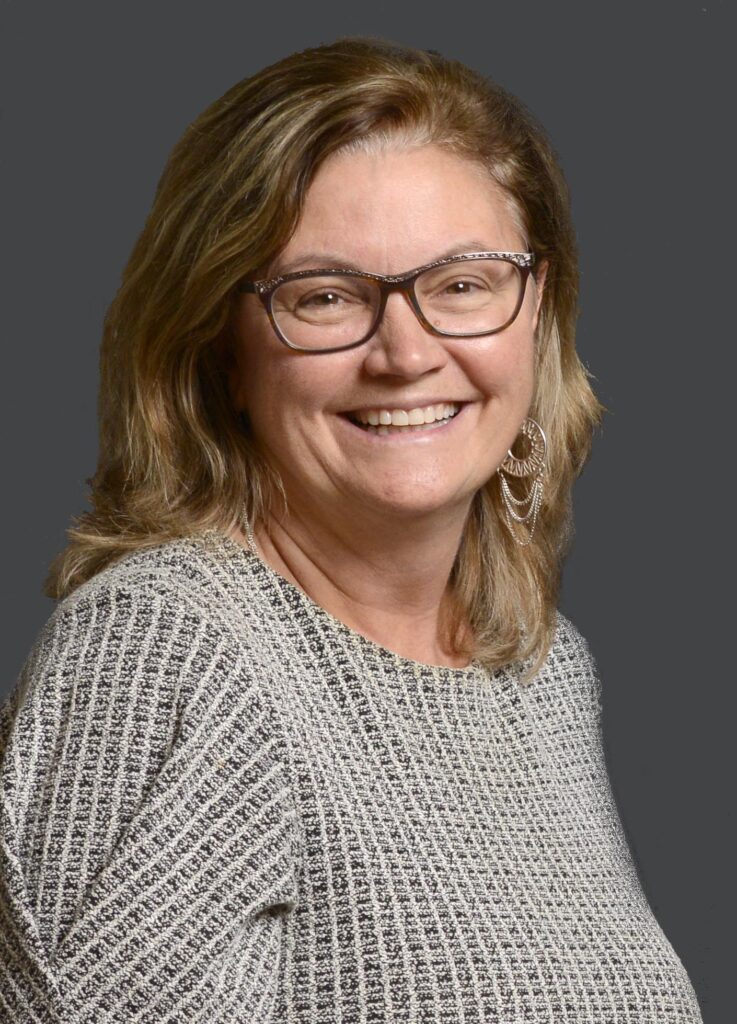
Nelly Pietropaolo, our beloved CivMin Director of Student Services and External Relations, will retire this year. To honour her achievements over more than 41 years at CivMin, and express our gratitude, the Nelly Pietropaolo Scholarship has been established.
Leading the way in initiating funding are alumni, especially from the Class of Civ 8T8, staff and faculty. Professor Emeritus Peter Wright expresses his eagerness to join in the widespread support, “Like many others, I owe much to Nelly’s enthusiasm and knowledge – my pleasure to help.”
Nelly is an inspiration to many of us – a trusted advisor, host, mentor, mom, confidante, and friend who has helped thousands of students through her decades-long career at U of T Engineering in the Department of Civil & Mineral Engineering (CivMin).
Starting her career at U of T in 1980, then joining CivMin in 1982, has seen Nelly rise through the ranks to her long-standing role as Director of Student Services and External Relations.
At some point, each undergraduate and graduate student has been in contact with her during their academic career and left the better for it. Be it a simple guidance with course selection or friendly hello, or even receiving a gift of homemade cookies, Nelly has left a lasting impression on each student. A reunion with each of our alumni usually yields the same result – a hug of gratitude for her compassion.
Supporting the next generation of thought leaders is the perfect way to recognize Nelly’s profound impact.
Don’t worry about her imminent departure, as Nelly will be leaving regular in-person office duties as of June 30, but will remain working until the end of calendar year.
To donate to the scholarship, visit: https://uoft.me/NellyPietropaoloScholarship
The following is part of a series introducing CivMin's undergraduate summer students to the Department and our greater community.
We explore the students' projects, motivation and challenges, while providing insights into who they are, and what motivates them, beyond academia. It also highlights the multitude of ways summer research opportunities are approached and implemented under the guidance of our industry-leading CivMin professors.
Meet our CivMin summer student: Haobo Zhao
 This summer, Haobo Zhao (CivE, Year 4) will be exploring the mine tailings problem and how to predict when mine tailing mountains might fail, under the supervision of Professor Mason Ghafghazi. Working in the Mechanics and Geotechnical Lab, Haobo is assisting Lizhi Qi (PhD candidate) with a number of tests to assess the strength of mine tailings. This work is contributing to the larger body of knowledge related to preventing the liquefaction of mine tailing mountains. Read more...
This summer, Haobo Zhao (CivE, Year 4) will be exploring the mine tailings problem and how to predict when mine tailing mountains might fail, under the supervision of Professor Mason Ghafghazi. Working in the Mechanics and Geotechnical Lab, Haobo is assisting Lizhi Qi (PhD candidate) with a number of tests to assess the strength of mine tailings. This work is contributing to the larger body of knowledge related to preventing the liquefaction of mine tailing mountains. Read more...
Meet our CivMin summer student: Sheen Patel
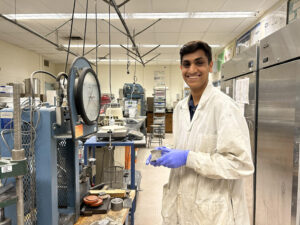 Sheen Patel (CivE, Year 3) has always been interested in concrete. He started exploring this research area in his first year when he joined U of T's Concrete Toboggan Team. This summer, he's collaborating with Exact Technology to develop a concrete sensor which will identify moisture levels at different depths over time, under the supervision of Professor Doug Hooton. His contribution to this project brings it one step closer to creating a user-friendly version of this device to be used by industry. Read more...
Sheen Patel (CivE, Year 3) has always been interested in concrete. He started exploring this research area in his first year when he joined U of T's Concrete Toboggan Team. This summer, he's collaborating with Exact Technology to develop a concrete sensor which will identify moisture levels at different depths over time, under the supervision of Professor Doug Hooton. His contribution to this project brings it one step closer to creating a user-friendly version of this device to be used by industry. Read more...
Meet our CivMin summer student: Rohan Wongkee
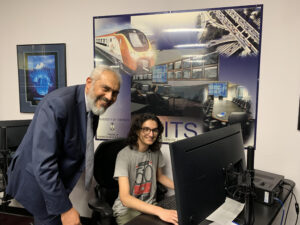 Rohan Wongkee (CivE, Year 3) has a talent for data analysis and a strong interest in the transportation research area. This summer, he’ll be exploring train delays and their impact on passengers within Toronto’s public transportation system, under the supervision of Professor Amer Shalaby. As a frequent TTC user himself, Rohan experiences these delays firsthand. His research will be contributing to improving overall user experience on public transportation. Read more...
Rohan Wongkee (CivE, Year 3) has a talent for data analysis and a strong interest in the transportation research area. This summer, he’ll be exploring train delays and their impact on passengers within Toronto’s public transportation system, under the supervision of Professor Amer Shalaby. As a frequent TTC user himself, Rohan experiences these delays firsthand. His research will be contributing to improving overall user experience on public transportation. Read more...
Meet our CivMin summer students: Rain Ferrer, Anass Janah and Madhavan Premrajka
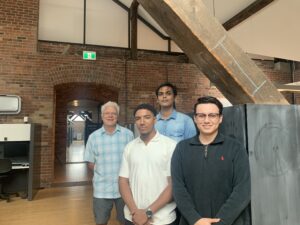 Rain Ferrer (MinE, Year 3), Anass Janah (Work-Study Student, Civil Engineering, Year 4, CESI de Bordeaux, France) and Madhavan Premrajka (Mining Engineering, Year 4, IIT Kharagpur, India) are all doing research under the supervision of Professor John Harrison this summer. When Rain heard about the research opportunity with Prof. Harrison, he immediately knew it was a position he couldn’t miss out on.
Rain Ferrer (MinE, Year 3), Anass Janah (Work-Study Student, Civil Engineering, Year 4, CESI de Bordeaux, France) and Madhavan Premrajka (Mining Engineering, Year 4, IIT Kharagpur, India) are all doing research under the supervision of Professor John Harrison this summer. When Rain heard about the research opportunity with Prof. Harrison, he immediately knew it was a position he couldn’t miss out on.
Anass and Madhavan join the team this summer as part of the Mitacs Global Research Initiative, which connects students with post-secondary institutions around the world for unique learning opportunities. Anass is pursuing a career in Civil Engineering in France, whereas Madhavan is pursuing Mining Engineering in India. India has been involved in this Mitacs initiative for years, and this is the first year France has participated. Read more...
Meet our CivMin summer students: Chris Kim and Catherine Ye
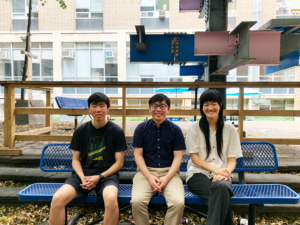 Chris Kim (EngSci, Year 2) and Catherine Ye (CivE, Year 4) are doing research about buildings and building systems this summer under the supervision of Professor Seungjae Lee. Both students are passionate about investigating and exploring the realm of building science. Chris is drawn to this research area because of its complexity and how interesting this makes the problem space, whereas Catherine is fascinated by the artificial intelligence and sustainability elements of building science. Read more...
Chris Kim (EngSci, Year 2) and Catherine Ye (CivE, Year 4) are doing research about buildings and building systems this summer under the supervision of Professor Seungjae Lee. Both students are passionate about investigating and exploring the realm of building science. Chris is drawn to this research area because of its complexity and how interesting this makes the problem space, whereas Catherine is fascinated by the artificial intelligence and sustainability elements of building science. Read more...
Meet our CivMin summer student: Lisa Guseva

From her first taste of transportation research, Lisa Guseva (CivE, Year 4) knew she wanted to pursue a career in the area. This summer, Lisa will be exploring e-cargo tricycle parking, under the supervision of Prof. Matt Roorda, Usman Ahmed (Postdoctoral Research Fellow leading the program with Purolator) and Farah Ghizzawi (PhD candidate researching commercial vehicle parking and behaviour simulation). Lisa's work will be part of a larger project, in partnership with Purolator, examining the performance of e-cargo bikes from a business, environmental and safety perspective. Read more...
Meet our CivMin summer students: Terry Liang and Ollie Zhao
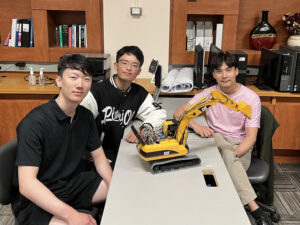 In the course Introduction to Civil Engineering (CIV201), Terry Liang (CivE, Year 3) and Ollie Zhao (CivE, Year 3) had the opportunity to tour campus and visit various professors and research groups. This is when they first learned about Professor Daeho Kim's research and knew it was an avenue they wanted to pursue. Prof. Kim ended up being Terry and Ollie's construction management professor, providing plenty of opportunity for inquiry about potential research opportunities. This summer, Terry and Ollie will be exploring the world of construction management and AI, under the supervision of Prof. Kim. Read more...
In the course Introduction to Civil Engineering (CIV201), Terry Liang (CivE, Year 3) and Ollie Zhao (CivE, Year 3) had the opportunity to tour campus and visit various professors and research groups. This is when they first learned about Professor Daeho Kim's research and knew it was an avenue they wanted to pursue. Prof. Kim ended up being Terry and Ollie's construction management professor, providing plenty of opportunity for inquiry about potential research opportunities. This summer, Terry and Ollie will be exploring the world of construction management and AI, under the supervision of Prof. Kim. Read more...
Meet our CivMin summer student: Maria Vetrici
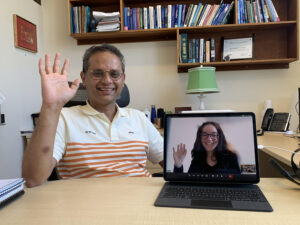 With various interests, Maria Vetrici (CivE, Year 2) originally started at U of T in the math and statistics program. After discovering her passion for urban geography and planning, Maria transferred into Civil Engineering. This summer, Maria is diving into the world of transportation and ride-sourcing services under the supervision of Prof. Khandker Nurul Habib. Read more...
With various interests, Maria Vetrici (CivE, Year 2) originally started at U of T in the math and statistics program. After discovering her passion for urban geography and planning, Maria transferred into Civil Engineering. This summer, Maria is diving into the world of transportation and ride-sourcing services under the supervision of Prof. Khandker Nurul Habib. Read more...
Meet our CivMin summer students: Emaan Fatima and Christopher Zuccaro
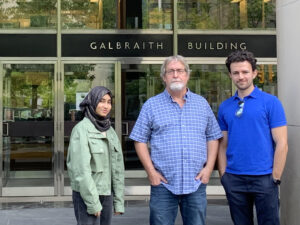 Emaan Fatima (EngSci, Year 3) and Christopher Zuccaro (CivE 2T2 + PEY, MASc candidate), both in different stages of their educational journey, found an interest in water and energy systems. With a passion for equity-based research, Emaan hopes she can help people and make a difference. Christopher began Civil Engineering with the intent of becoming a civil engineer but once he took Professor Bryan Karney's course, CIV 250 - Hydraulics and Hydrology, he knew he wanted to pursue a future career involving the topic of water. This summer, Emaan and Christopher are both working as research students in CivMin, under the supervision of Prof. Karney. Read more...
Emaan Fatima (EngSci, Year 3) and Christopher Zuccaro (CivE 2T2 + PEY, MASc candidate), both in different stages of their educational journey, found an interest in water and energy systems. With a passion for equity-based research, Emaan hopes she can help people and make a difference. Christopher began Civil Engineering with the intent of becoming a civil engineer but once he took Professor Bryan Karney's course, CIV 250 - Hydraulics and Hydrology, he knew he wanted to pursue a future career involving the topic of water. This summer, Emaan and Christopher are both working as research students in CivMin, under the supervision of Prof. Karney. Read more...
Meet our CivMin summer students: Freddy Fisher, Fabio Karanja and Flora Thang
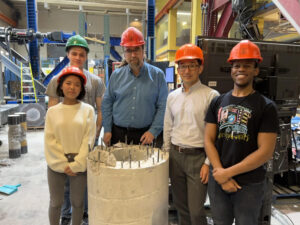
Undergraduate students Freddy Fisher, Fabio Karanja and Flora Thang all found themselves drawn to Structural Engineering. They all took Structural Analysis I (CIV214), taught by Professor Oh-Sung Kwon, and are now doing summer research under the co-supervision of Professors Kwon and Evan Bentz. Freddy, Fabio and Flora will be supporting two graduate students' research on nuclear containment structures leakage and the impact of high temperatures on certain materials. They've also been assigned their own personal projects. Read more...
Meet our CivMin summer student: Gordon Tan
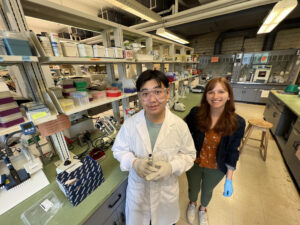 Gordon Tan’s father is a civil engineer. He grew up learning about indoor air quality, sparking his interest in this area. Now, as an undergraduate student, Gordon is doing summer research on mycotoxins and its impact on indoor air quality, under the supervision of Professor Sarah Haines. The literature on this research area is limited; for Gordon, this is motivation to further explore this topic area. He hopes to shine a spotlight on the importance of examining exposures in our indoor environment and to spark further research on mycotoxins. Read more...
Gordon Tan’s father is a civil engineer. He grew up learning about indoor air quality, sparking his interest in this area. Now, as an undergraduate student, Gordon is doing summer research on mycotoxins and its impact on indoor air quality, under the supervision of Professor Sarah Haines. The literature on this research area is limited; for Gordon, this is motivation to further explore this topic area. He hopes to shine a spotlight on the importance of examining exposures in our indoor environment and to spark further research on mycotoxins. Read more...
Meet our CivMin summer students: Noureen Abdelhalim and Abdul Moiz Syed
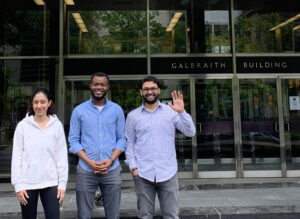
Undergraduate students Noureen Abdelhalim and Abdul Moiz Syed both took an interest in material science after taking Professor Ibrahim Ogunsanya’s CIV209 - Civil Engineering Materials class. Both are now diving deeper into this area as research students in CivMin this summer, under the supervision of Prof. Ogunsanya. Though they have differing career aspirations, they share a deep appreciation for the importance of materials - a part of engineering often overlooked and forgotten about. Read more...
Congratulations to the Class of 2T3 and 2T2 + PEY – our newest alumni!
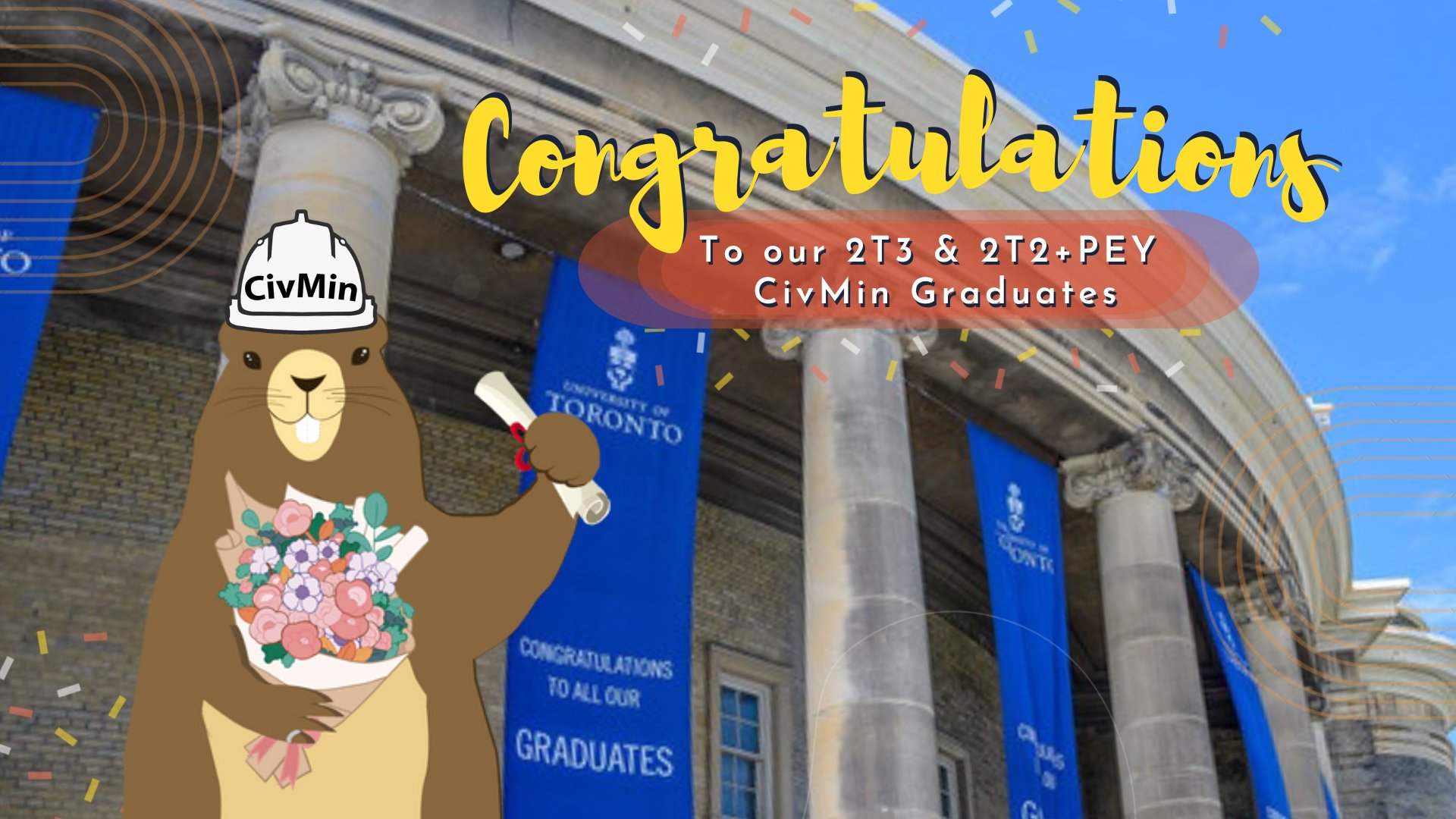
Convocation ceremony on Tuesday, June 20, 2023.
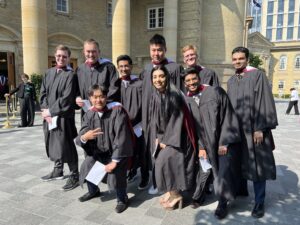
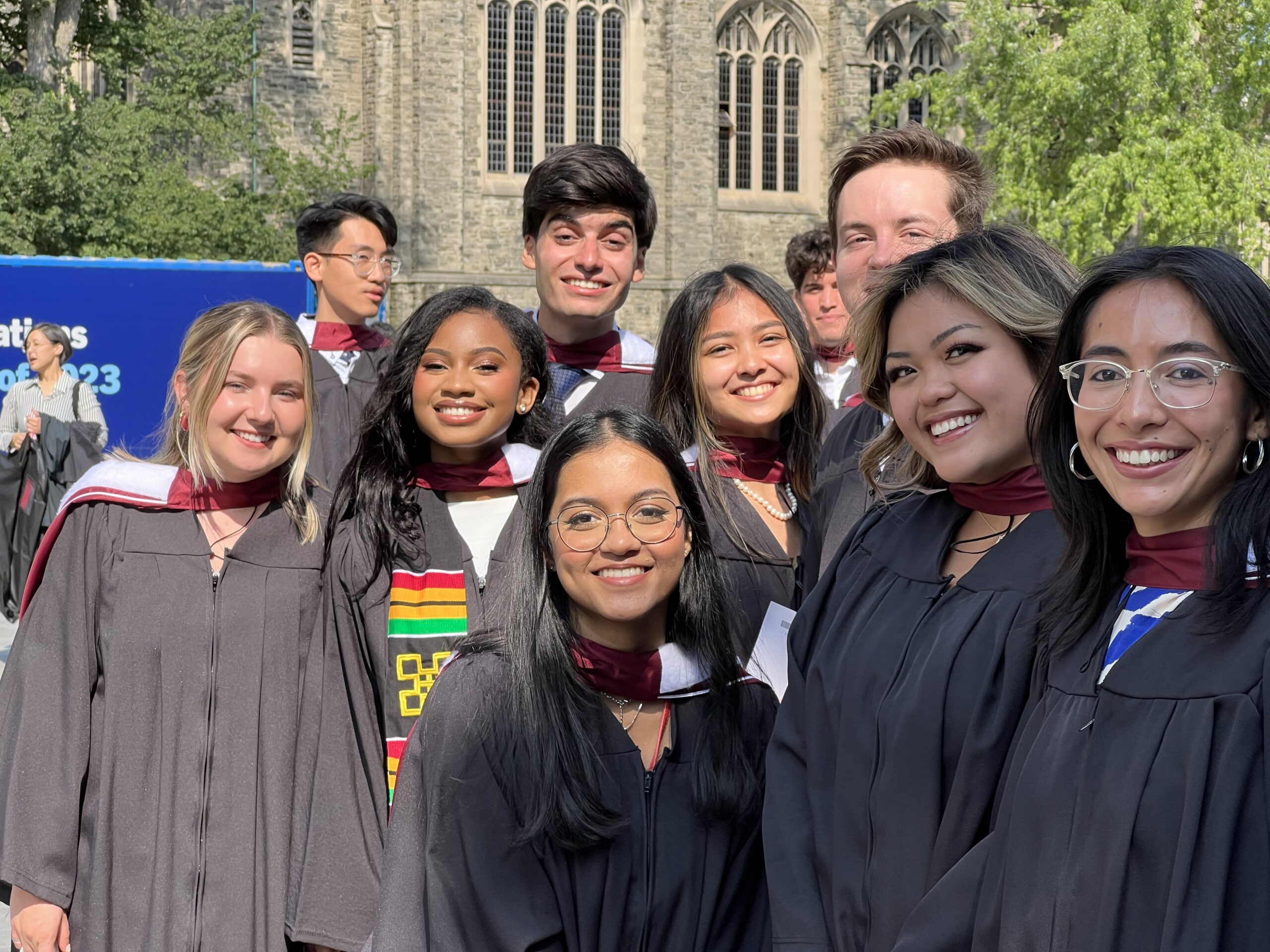
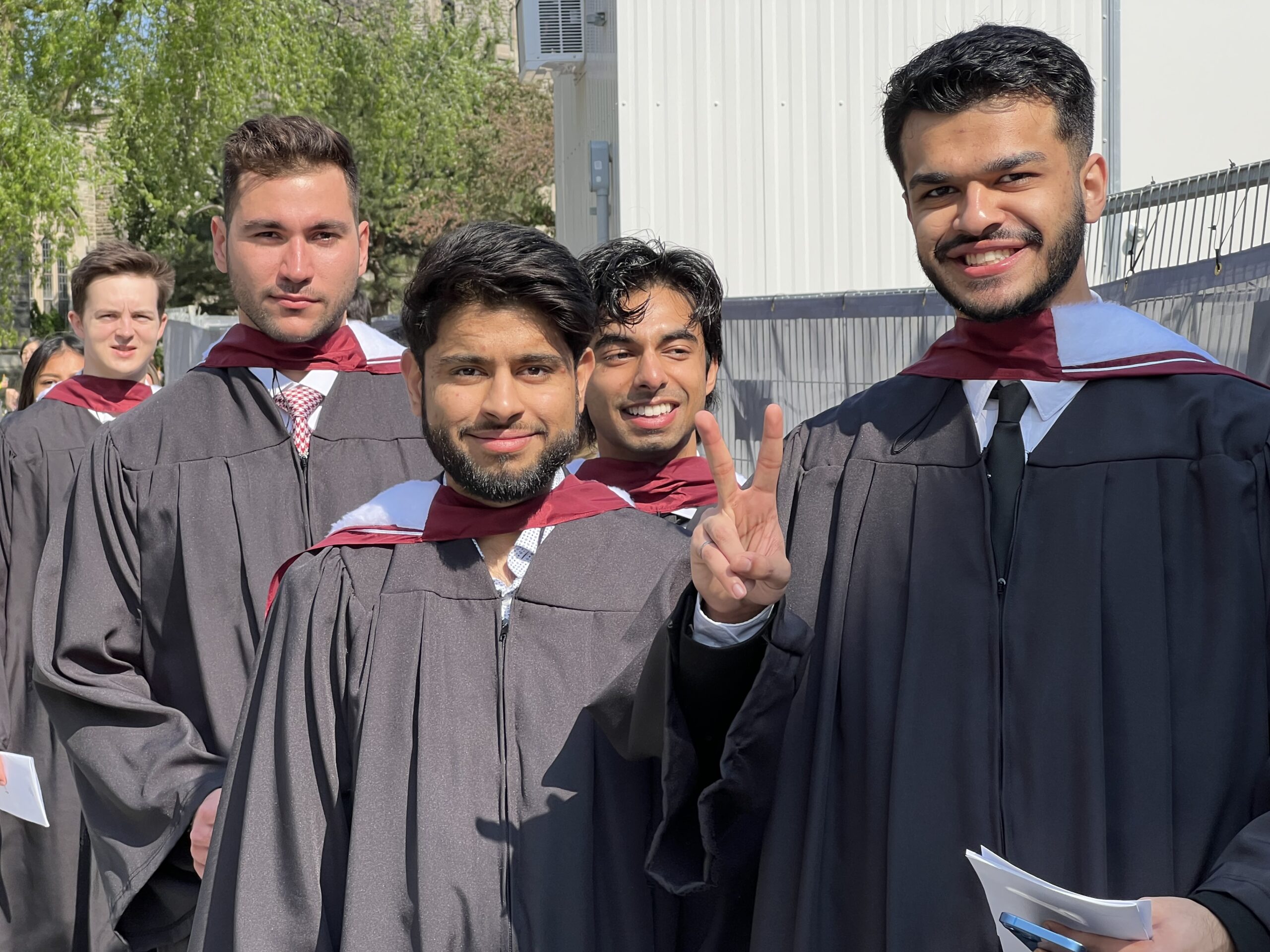
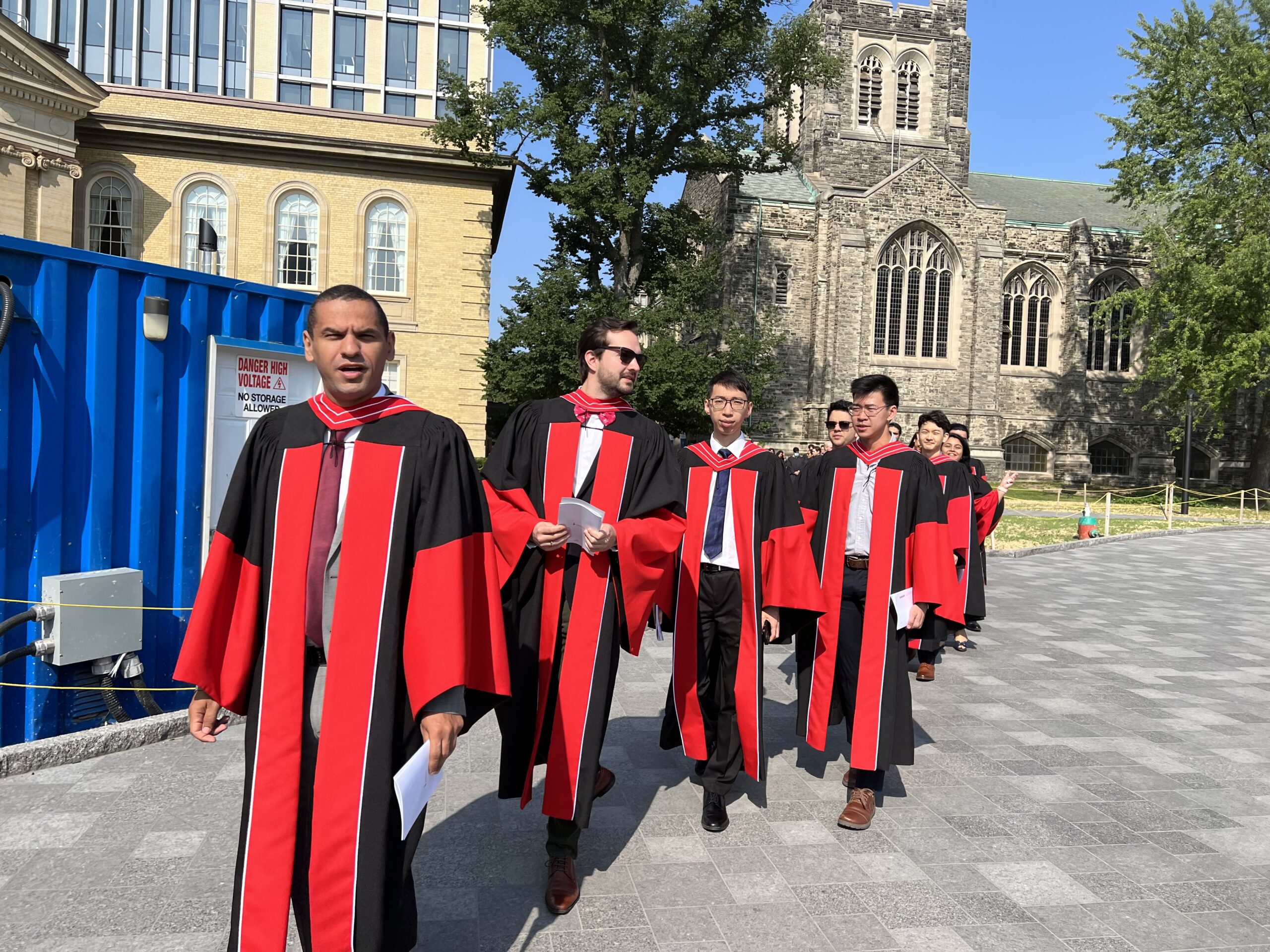
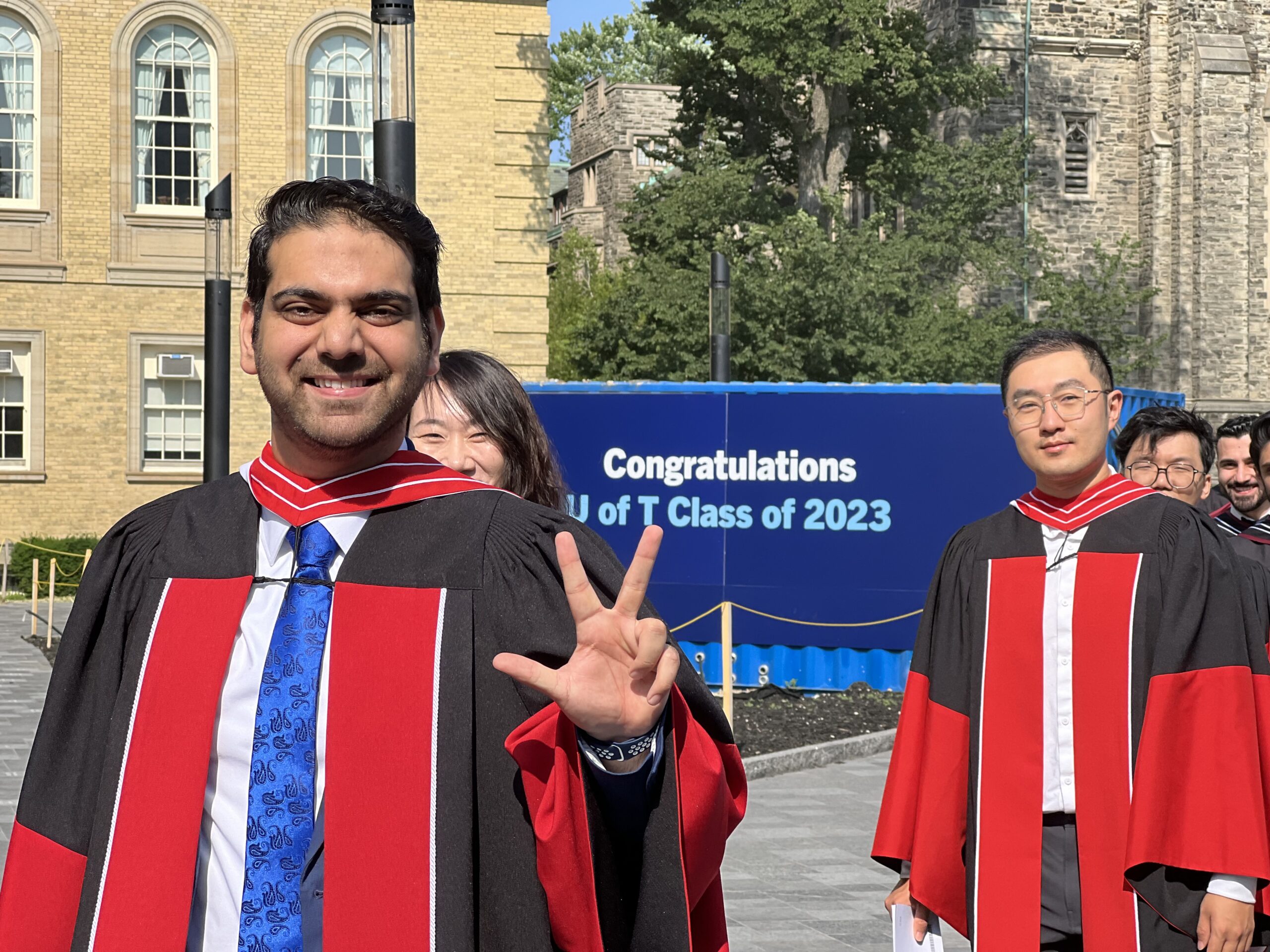
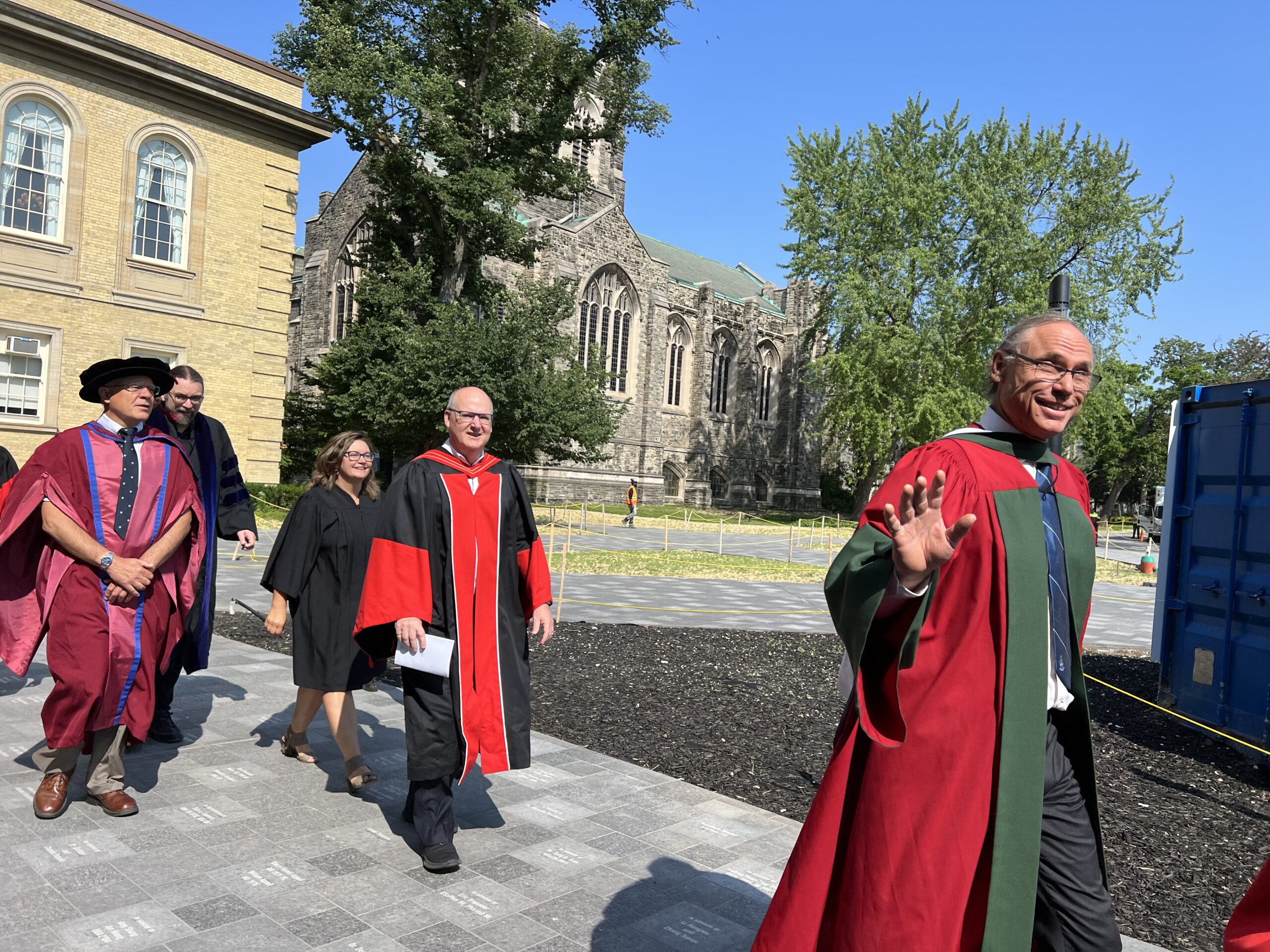
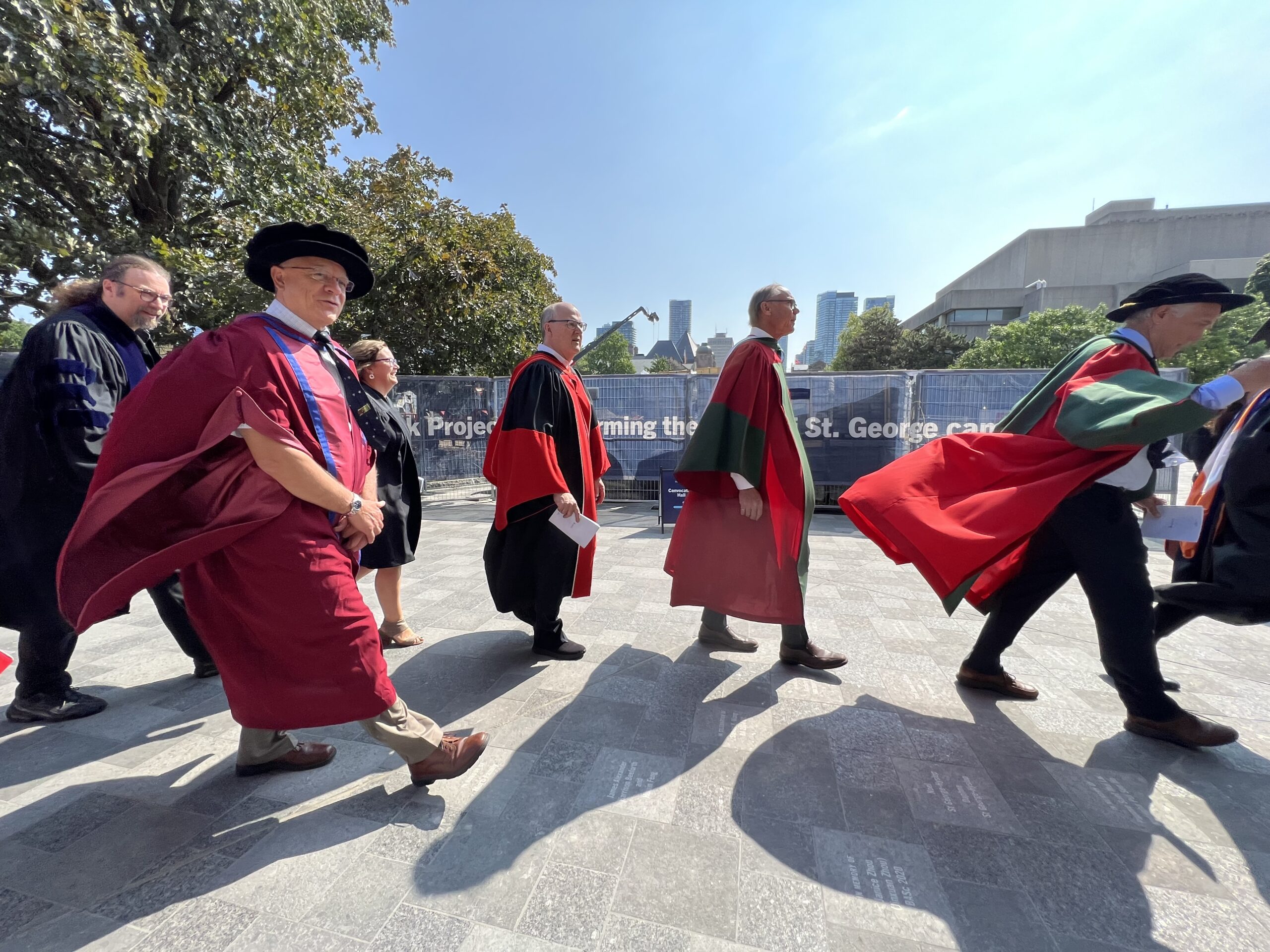
The original Class of 2T3 …1923!
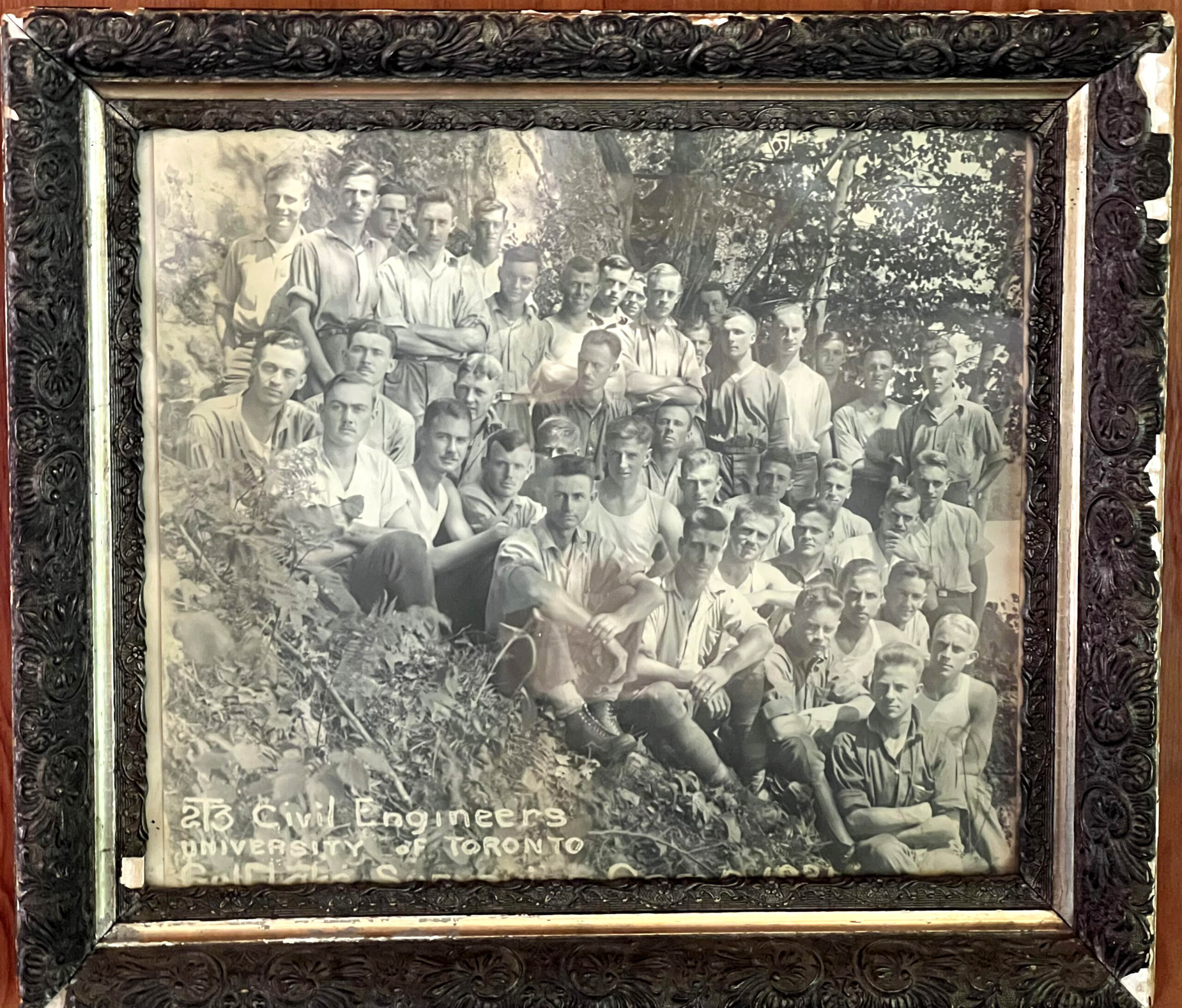
The original Class of 2T3 from 1923 during their summer at Camp in August of 1921.
You’re now joining a network of over 50,000 U of T Engineering Alumni.
Please do stay connected with the CivMin community as a member of the Engineering Alumni Association, which offers many alumni benefits and supports. Keep your contact info up-to-date through U of T Engineering CONNECT to stay informed about special events and opportunities in your region.
To find social media posts, please follow the hashtags:
#UofTGrad23 #Classof2T3 #CivMin
A full list of our graduates:
Faculty of Applied Science & Engineering
_______________________________________________________
Doctor of Philosophy
_______________________________________________________
Aly Abdelaziz
Civil and Mineral Engineering
Zahra Ansarilari
Civil and Mineral Engineering
Jose Luis Cadavid Cardenas
Chemical Engineering and Applied Chemistry
Ka Ho Chan
Chemical Engineering and Applied Chemistry
Patrick Diep
Chemical Engineering and Applied Chemistry
Hamed Ghazisaidi
Chemical Engineering and Applied Chemistry
Sung Hwa Hong
Chemical Engineering and Applied Chemistry
Sanjana Hossain
Civil and Mineral Engineering
Jahanzaib
Civil and Mineral Engineering
Jessica Wan-Yan Ngai
Chemical Engineering and Applied Chemistry
Thi Van Anh Nguyen
Chemical Engineering and Applied Chemistry
Muhammad Faizan Qureshi
Civil and Mineral Engineering
Azadeh Vatandoust
Chemical Engineering and Applied Chemistry
Omar Bashir Wani
Chemical Engineering and Applied Chemistry
Yin Yin
Civil and Mineral Engineering
Jiakai Zhang
Chemical Engineering and Applied Chemistry
Chiyun Zhong
Civil and Mineral Engineering
_______________________________________________________
Master of Applied Science
_______________________________________________________
Malik Mohamed Arfaa Awan
Civil and Mineral Engineering
Çağcan Çal
Civil and Mineral Engineering
Vartkes Davidian
Civil and Mineral Engineering
Mehmet Duyan
Earth Sciences
Fiona Fox
Civil and Mineral Engineering
Lucas Herzog Bromerchenkel
Civil and Mineral Engineering
Gwyneth Nicole Jordan
Chemical Engineering and Applied Chemistry
Brenden Lavoie
Civil and Mineral Engineering
Timileyin Mujib Oyinkanola
Civil and Mineral Engineering
Brendan Robbins
Chemical Engineering and Applied Chemistry
Kirtan Brar Singh
Civil and Mineral Engineering
Phyllis Shin-Yu Wu
Civil and Mineral Engineering
Hang Zuo Xiang
Chemical Engineering and Applied Chemistry
Andrew Benjamin Young
Civil and Mineral Engineering
_______________________________________________________
Master of Engineering
_______________________________________________________
Saad Akbar
Civil and Mineral Engineering
Anas Alabdullah
Civil and Mineral Engineering
Anjana Sajeev
Civil and Mineral Engineering
Annie Attah
Chemical Engineering and Applied Chemistry
Simrat Singh Bhutani
Chemical Engineering and Applied Chemistry
Geoffrey Boddy
Civil and Mineral Engineering
Oluwadamilola David Bolarin
Chemical Engineering and Applied Chemistry
Weiwu Chen
Civil and Mineral Engineering
Zhirong Chen
Chemical Engineering and Applied Chemistry
Ricardo Cortes Landa
Chemical Engineering and Applied Chemistry
Juan Pablo Cortes Rubiano
Civil and Mineral Engineering
Xinjun Cui
Chemical Engineering and Applied Chemistry
Isabela Diadami Perez
Civil and Mineral Engineering
Mohammad Tawfic Doudar
Civil and Mineral Engineering
Rachel D’Silva
Civil and Mineral Engineering
Tianjie Feng
Chemical Engineering and Applied Chemistry
Shaghayegh Ghorbani
Civil and Mineral Engineering
Navneet Grewal
Civil and Mineral Engineering
Rahul Brijbhushan Gupta
Chemical Engineering and Applied Chemistry
Ahmad Haj Rahmoun
Civil and Mineral Engineering
Joshua Ernest Hamilton
Civil and Mineral Engineering
Chenyu Huang
Civil and Mineral Engineering
Samira Musherrof Hussain
Civil and Mineral Engineering
Nandini Jain
Chemical Engineering and Applied Chemistry
Shuaib Ahmed Jamadar
Civil and Mineral Engineering
Nour Kabalan
Chemical Engineering and Applied Chemistry
Uzay Kaya
Civil and Mineral Engineering
Donghee Kim
Civil and Mineral Engineering
Weiqing Kong
Civil and Mineral Engineering
Chee Ching Felice Lam
Civil and Mineral Engineering
Heon Young Lee
Civil and Mineral Engineering
Bisman Lehal
Chemical Engineering and Applied Chemistry
Bai Li
Chemical Engineering and Applied Chemistry
Mingzhe Li
Civil and Mineral Engineering
Wenjie Li
Civil and Mineral Engineering
Run Ming Liao
Civil and Mineral Engineering
Wei Lin
Civil and Mineral Engineering
Zirui Liu
Civil and Mineral Engineering
Manoj Chandra Machavolu
Chemical Engineering and Applied Chemistry
Mahdiyar Mougouei
Civil and Mineral Engineering
Renuka Shivani Muniswamy
Chemical Engineering and Applied Chemistry
Naayaab Nagree
Chemical Engineering and Applied Chemistry
Lina Maria Navia Ramirez
Civil and Mineral Engineering
Patience Olsen
Civil and Mineral Engineering
Daniela Ospina Pedraza
Civil and Mineral Engineering
Prashan Chandubhai Patel
Civil and Mineral Engineering
Yash Pravin Patel
Chemical Engineering and Applied Chemistry
Ayushi Pitchika
Chemical Engineering and Applied Chemistry
Sricharan Poyyamozhi
Chemical Engineering and Applied Chemistry
Xingyang Qiu
Chemical Engineering and Applied Chemistry
Harshavarrdhan Saravanan
Civil and Mineral Engineering
Rahavi Selvarajah
Civil and Mineral Engineering
Mohamed Ibrahim Shibly
Chemical Engineering and Applied Chemistry
Supriya Shivanna
Chemical Engineering and Applied Chemistry
Nidhi Singh
Civil and Mineral Engineering
Jacob Brennan Smith
Chemical Engineering and Applied Chemistry
Mohana Murali Sridharan
Chemical Engineering and Applied Chemistry
Wanting Su
Civil and Mineral Engineering
Sevil Tabrizi Miandoab
Chemical Engineering and Applied Chemistry
Andres Gilberto Toro Rey
Civil and Mineral Engineering
He Wang
Civil and Mineral Engineering
HongJie Wang
Civil and Mineral Engineering
Yumeng Wang
Civil and Mineral Engineering
Sylvie Wichert
Civil and Mineral Engineering
Yi Fan Wu
Civil and Mineral Engineering
Minwei Yang
Civil and Mineral Engineering
Sarah Zahedie
Civil and Mineral Engineering
Hao Zhang
Civil and Mineral Engineering
Ruijie Zhang
Civil and Mineral Engineering
Shengwei Zhang
Civil and Mineral Engineering
_______________________________________________________
Master of Engineering in Cities Engineering and Management
_______________________________________________________
Jeremy Benjamin Bertrand
Xianshuo Chen
Jie-Ying Jennie Cheung
Larry Cheuk Yin Kei
Sadia Khan
Niti Jayesh Lad
Albert Layarda
Mohit Mathew
Lavina Hsiao Wei Ng
Qing Su
Mohammed Suhail
Ruoting Yu
Maxim Zemlyanoy
_______________________________________________________
Bachelor of Applied Science in Engineering Science
_______________________________________________________
Benjamin Taylor Caldwell Agro HH
Nicole Anna Amenta H
Sooyeon Bae
Spencer Steven Ball
Savanna Grace Blade H
Raissa Nicoly Bonon
Michael Christopher Boyadjian
Camille Elisabeth Bruckmann HH
Yviel Castillejos H
Elif Celik
Nayoung Chae HH
Adithya Chakravarthy H
Jerry Chen H
Jiarong Chen
Jondy Chen H
Benjamin Cheng HH
Brian Sai-Heng Cheong HH
Mingshi Chi
Katarina Karen Chiam H
Kajanan Chinniah H
David Lawrence Chu HH
Hyungin Chun H
Serena Ann Crne H
Wei Hai Cui H
Adriana Diaz Lozano Patino
Elisa Ding
Ro Victor Doherty H
Hisham El-Halabi H
Jonathan Robert Esparaz
Adam Fahs H
Taylor Jade Faiczak H
Tianyimeng Fang
Maxwell Kevin Fingold H
Michal Fishkin H
Donna Yufei Gao HH
Samuel Raymond Gaskin H
Shardul Sunil Ghuge H
Nikoo Givehchian
Catherine Rose Glossop H
Connor Glossop
Aidan William Grenville H
Marcus Edward Grunnesjö HH
Edward Guan
Catherine Guo H
Zouhair Adam Hamaimou H
James Ronald Han HH
Leo Xian-chen Han H
Travis Harrison H
Jasper David Coombs Hatton H
Esther Jau-Rung He H
Yiming He H
Zhao Zhi Jordan Hong H
Noah James Bracken Hosein HH
Sepehr Hosseini Khorasgani H
Kevin Hu H
Tianxi Hu
Christine Huang H
Saksham Jain H
Shrey Jain
Saeed Ahmed Jan H
Geoffrey Tian Yang Jiang
Arsh Neel Kadakia H
Mohammad Rafay Kalim H
Batuhan Raif Karagoz H
Drini Kerciku H
Saumik Shuddho Khan
Soroush Khoubyarian HH
Minjun Kim H
Won-Jin Kim
Vuk Kliska
Liam Isaac Koch Nichol H
Sheral Sweta Kumar H
Markus John Kunej
Yun Hao Lai HH
Armaan Ihsan Lalani H
Nicola Tatyana Lawford HH
Aidan Christopher Lawford-Wickham H
Chang-Won Lee H
Sumin Lee H
Anthony Jia-Hao Lem H
Matthew Ching Ho Leung HH
Chenqi Li HH
Reina Ke Xin Li HH
Xing Hao Li HH
Xuanze Li H
Yong Da Li H
Youyang Li H
Zehua Li HH
Rui Liang H
Xinyu Liang H
Yu Ying Liang H
Lorna Licollari
Noelle Lim
Anton Liu
Tony Zhi-Yuan Liu H
Yining Liu HH
Yanni Lu H
Daniela Alexandra Luna Yong
Xin Yu Ma H
Tamara Viveka Mahbubani
Mobin Malmirian
Yanwen Mao
Gonzalo Martinez Santos H
Timothee Albert Victor Mazerolle
Kohava Mendelsohn H
Shyam Menon
Mirjana Mijalkovic
Brandon Charles Miller H
Danylo Mogyl’nyy
Jaydeep Aniruddha Mohile H
Predrag Muratovic
Siddarth Narasimhan H
Dorri Ben Natra Ihilov
Helen Anna Newton
Eduardo Andres Ortiz
Jyotiraditya Panda H
Dhairya Patel HH
Saiyam Kiran Patel
Smit Patel
Xi Man Peng HH
Kevin Daniel Porras HH
Louis Da-syin Primeau H
Xinyuan Qiao HH
Gunvir Singh Ranu H
Divy Raval HH
Aiden Roel Rosebush H
Daniel Peter Rossos
Rocco Tian Lang Ruan H
George-Kirollos Yousry Guirguis Youssef Saad H
Esmat Ullah Sahak H
Harishguna Satgunarajah
Young Seok Seo H
Natalie Shafik H
Abdul Rahman Shahzad
Daniel Alec Sheen
Jianzhong Shi H
Chloe Julia Shin-Gay H
Solvin Lorenz Sigurdson HH
Kanav Singla H
Tengyu Song H
Victoria Rose Spada H
Jonathan Thomas Kai-Wei Spraggett
Lauren Paige Streitmatter HH
Prachi Kishore Sukhnani
Jake Patrick Sullivan
Ethan Tang
Spencer Josiah Teetaert H
Milana Rose Thibodeau-Morris H
Eddie Chongyu Tian
Alexi Reese Tracey HH
Olivia Sara Curtis Tracey
Justin Bao Tran H
Emily Julia Traynor
Samantha Dalia Unger HH
Kerryn Van Rooyen H
Ketan Kumar Vasudeva H
Kelvin James Wallace
Hailin Wang H
Haochen Wang HH
Haoran Wang H
Ru Shi Wang
Yutong Wang
Daniel Christopher Wing
Cameron Scott Witkowski HH
Grace Wu H
Man Qiu Wu HH
Maxx Sishu Wu HH
Mulan Wu
Sean Wu H
Theodore Wu HH
Linjing Xin H
Justin Xu
Yixuan Xu H
Vo Christian Chavez Yagong H
Chan Hyuk Yang H
Richard Jiarui Yang H
Zongyan Yao
Esther Yoo H
Tian Miao Yu HH
Jason Zanchun Yuan H
Yazan Taiser Ibrahim Ahmed Zamel H
Ryan Zazo H
Christian Alexander Zeni
Haochen Zhang HH
Jiarui Zhang H
Xiao En Zhang H
Maxwell Zhiyuan Zheng
Si Cheng Zhong HH
Tao Zhong HH
Xiaoyan Zhou HH
Yue Zhuang H
Johnathan Alexander Zachariah Zimmermann H
Xiangyu Zou HH
Elizabeth Marie Zoubakina H
_______________________________________________________
Bachelor of Applied Science
CHEMICAL ENGINEERING
_______________________________________________________
Chaitanya Ahuja H
Chananya Aimrattanalert H
Abdultayeb Huzefa Akberali
Hana Aljammal
Amro Aswad H
Pierce Au H
Bayan Bader
Ivan Anthony Baric
Chynna Beattie H
Sarah Lucy Birch H
Anne Blue H
Yao Sheng Chai H
Carmelle Shefali Chatterjee
Chang Chun Chen H
Lucy Chen
Xiaobo Chen H
Ziyu Chen H
Krisco-Cheuk Yee Cheung HH
Shu-Yin Alice Chew H
Bugeon Choi
Nada Dalal
Emily Heidi Dawe
William Elliot De Angelis HH
Diana Dyussekenova H
Pablo Samuel Espinal
Xingyu Feng H
Aseem Partap Singh Gill H
Mackenzie Christian Gole HH
Stella Rose Gregorski H
Charles Lorne Kobelak Hamilton
Alex Jeonghwan Han
Edward Hsieh H
Ling Wei Hwang HH
Huanyu Jiang
Andrew Kang H
Gehna Karani
Jacob Marcel Kennedy H
Nadiha Khan H
Sartaaj Takrim Khan H
Nikhil Konduru H
Alexandra Kousinioris HH
Bianca Ngan Lam Lau
Matvey Lebedev
Matthew Raymond Lee
Chen Yu Li H
Nathan Lieu H
Muskan Asif Malek H
Meghan Juana Lee Meneses H
Zheyuan Miao HH
Zachary James Molloy H
Celine Mustafa Moussa
Muhammad Anaqi Muhamad Afendi
Niroshini Muniandy H
Alyssa Jane Nodello H
Stephanie Ezinne Obeta H
Olevia Pal H
Sunny Park H
Jason Luke Pereira H
Chenhui Qi H
Vashish Ritesh Ramoutar
Alton Oliver Rego H
Abel Rodriguez
Maryam Bente Shahid
Daniel Yaming Shi H
Eunbee Shin H
Benjamin Elliot Shore H
Mayank Singh H
Mariel Stanco
Chuan Hui Sun HH
Adam Tin-Ching Tam HH
Danica Elizabeth Temesy
Purushoth Thavendran H
Megan Leigh Ty HH
Taya Liisa Vanderkop-Girard H
Ruiyu Wang
Kimberly Kimiko Watada H
Lindsay Anne Wells
Ziting Xia HH
Shunli Yao
Saad Muhammed Yasin
Zi Yin
Jia Yu H
Dachuan Zhang H
Jilai Zhang HH
Xinyu Zhang H
Yilin Zhang H
Kehan Zhao
Rulangyue Zhao
Austin Zhi Hao Zheng H
Huaqing Zheng H
Yuqi Zhou H
Mengdie Zhuang
_______________________________________________________
Bachelor of Applied Science
CIVIL ENGINEERING
_______________________________________________________
Muhammad Abdullah
Hawaiz Ahmed H
Irteza Nahiyan Ahmed
Iskender Fehmi Eren Akdora
Luna Valentina Amador H
Kryztal Kaitlyne Arcilla
Aidan John Ashton H
Vanessa Elizabeth Ayoung-Chee H
Alana Jeneva Bailey
Shrabanti Biswas H
Emma Shan Grace Blewett H
Christian Patrick Calarco HH
Gaspare Castagna
Stefano Castellaneta
Siu Kai Cheung H
Christian Paul Colantonio H
Georgia Rae Collins H
Mary Daka
Cameron Blake Dawson
Emanuele Dell’Olivastro H
Mahmoud Ahmed AlAdl Mohamed Derbala HH
Daniela Teresa Dilisi H
Camilo Dugand H
Selena Catherine Foster
Samantha Louise Fraser
Guanye Gao
Khashayar Ghaedsharafi
Madison Kate Grdisa
Victoria Maria Gwizdala H
Emil Tobias Rudå Hagaseth
Avery Isaac Hoffer HH
Jade Huangfu H
Nina Fadi Jauhari Yehia
Sepehr Javidan H
Kayembe Joseph Kamangu
Yaqoub Sayed Karimzad
Abigail Song Hee Kim H
Sina Lakbala
Michelle Leon Rosero H
Haofeng Liu
Yikai Liu
Binuji Nuwanmee Liyanage
Jiating Lou H
Xiang Luo
Yan Luo H
Clarence Hei Chit Mak H
Neha Marfani
Emiko Grace Marr H
Michael Joseph Samuel Metallo
Margalit Mirlas
Fahd Mobada H
Andrew Wing Ka Ng
Sydney Ng
Bryan Nguyen H
Keziah Hembadoon Nongo
Rumla Omer
Fariha Tahseen Oyshee
Rodrigo Sebastian Plascencia
Samuel Restrepo H
Christopher Mark Anthony Ruus H
Nathaniel George Rzepka
Yuan Yi Shi H
Christian Alexander Smith H
Kent Frederick Straky
Heng Sun
Melanie Christina Tham H
Kumaran Thanabalasingam
Naomi Shiyu Tian
Joshua Thomas Varughese HH
Matthew Bruno Vidale
Kathleen Anne Vranesic
James Anthony Johan Wagner H
Ellen He Wang H
John Bernard Bott Weiler
Dawit Shibeshi Yoseph
Naveen Afroz Zaman H
Melanie Dejia Zhang H
Zhi Rou Zhang H
Christopher Francesco Zuccaro H
______________________________________________________
Bachelor of Applied Science
LASSONDE MINERAL ENGINEERING
_______________________________________________________
Peter Titus Anderson
Alexander James Gilvesy
Shaan Hudani
Shi Kai Li
Komal Mann
Michael Cameron McCulloch H
Joseph Nathaniel Naresh Persaud
William John Priestner
Shivan Singh
Kyle Wong